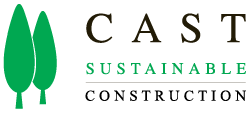The Living Building Challenge (LBC) is a ‘green’ building certification program that defines the most advanced measure of sustainability for buildings and landscapes today. At Cast Sustainable, we strive to incorporate many of the guidelines and initiatives set out by the LBC to bring a more natural, sustainable living environment. With their strong support for eco-friendly residential projects, the districts of North Vancouver and West Vancouver are ideal for the Living Building Challenge.
The Living Building Challenge is a holistic approach to building and is the future of green construction.
Elements Of The Living Building Challenge
There are six key components to the LBC; Place, Water, Energy, Health and Happiness, Materials, Equity, and Beauty. Each one comes with specific requirements to the construction of a building.
Place
The intent is to realign how people understand and relate to the natural environment which sustains us. The built environment must reconnect with the natural surroundings. To meet this criteria of LBC, we must understand how to protect and restore the area after building. Construction must also encourage limited transportation and human powered living, while promoting local food production.
Water
The intent is to realign how people use water and respect it as a precious resource. All project water requirements must be supplied by captured precipitation or other closed loop water systems. All storm water or discharge water must be treated on site and managed.
Energy
With the Energy component, the intent is to create a new age of design, wherein the built environment relies solely on renewable, clean energy. Living Building Challenge articulates that 105% of projects energy needs must be supplied by on-site renewable energy.
Health and Happiness
For Health and Happiness, the intent is to focus on the most important environmental conditions that must be present to create robust, healthy spaces for everyone. The elements most important to Health and Happiness is to promote good indoor air quality and include design elements that nurture the innate human/nature connection.
Materials
Utilizing materials that are non-toxic, ecologically regenerative, transparent and socially equitable. Throughout their lifecycle, building materials are responsible for environmental issues, personal illnesses, habitat and species loss, pollution and resource depletion. The project must account for the total embodied carbon (tCO2e) impact from its construction. It must involve Living Economy Sourcing and contribute to the expansion of a regional economy rooted in sustainable practices, products and services. Lastly, the project team must strive to reduce the production of waste during design, construction and operations.
Equity
Equity is intended to transform developments to foster an inclusive sense of community for all people. It must create an experience that brings out the best in humanity, and promotes culture and interaction. It may not block access nor diminish quality of fresh air, sunlight, and natural waterways for any member of society. And for every dollar cost of project the development must set aside and donate ½ cent or more to a charity.
Beauty
To recognize the need for beauty as a precursor to caring enough to preserve, conserve and serve the greater good. The project must contain design features intended solely for human delight and celebration of culture, as well as contain educational material on the operation and performance of the project.

